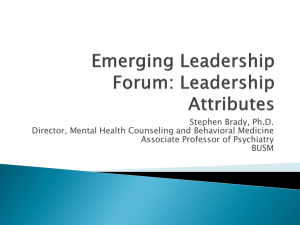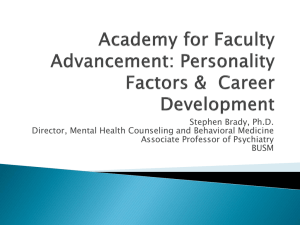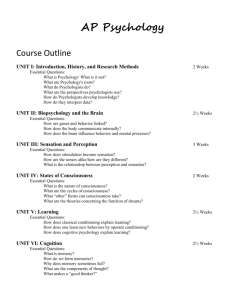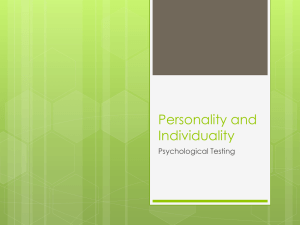File
advertisement
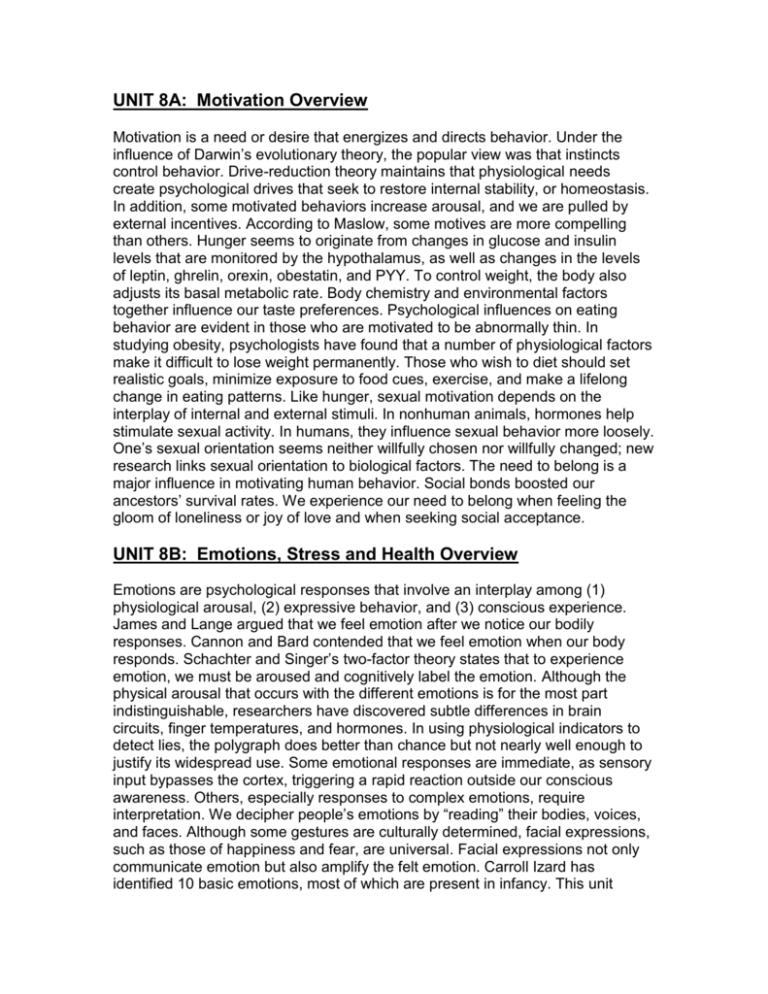
UNIT 8A: Motivation Overview Motivation is a need or desire that energizes and directs behavior. Under the influence of Darwin’s evolutionary theory, the popular view was that instincts control behavior. Drive-reduction theory maintains that physiological needs create psychological drives that seek to restore internal stability, or homeostasis. In addition, some motivated behaviors increase arousal, and we are pulled by external incentives. According to Maslow, some motives are more compelling than others. Hunger seems to originate from changes in glucose and insulin levels that are monitored by the hypothalamus, as well as changes in the levels of leptin, ghrelin, orexin, obestatin, and PYY. To control weight, the body also adjusts its basal metabolic rate. Body chemistry and environmental factors together influence our taste preferences. Psychological influences on eating behavior are evident in those who are motivated to be abnormally thin. In studying obesity, psychologists have found that a number of physiological factors make it difficult to lose weight permanently. Those who wish to diet should set realistic goals, minimize exposure to food cues, exercise, and make a lifelong change in eating patterns. Like hunger, sexual motivation depends on the interplay of internal and external stimuli. In nonhuman animals, hormones help stimulate sexual activity. In humans, they influence sexual behavior more loosely. One’s sexual orientation seems neither willfully chosen nor willfully changed; new research links sexual orientation to biological factors. The need to belong is a major influence in motivating human behavior. Social bonds boosted our ancestors’ survival rates. We experience our need to belong when feeling the gloom of loneliness or joy of love and when seeking social acceptance. UNIT 8B: Emotions, Stress and Health Overview Emotions are psychological responses that involve an interplay among (1) physiological arousal, (2) expressive behavior, and (3) conscious experience. James and Lange argued that we feel emotion after we notice our bodily responses. Cannon and Bard contended that we feel emotion when our body responds. Schachter and Singer’s two-factor theory states that to experience emotion, we must be aroused and cognitively label the emotion. Although the physical arousal that occurs with the different emotions is for the most part indistinguishable, researchers have discovered subtle differences in brain circuits, finger temperatures, and hormones. In using physiological indicators to detect lies, the polygraph does better than chance but not nearly well enough to justify its widespread use. Some emotional responses are immediate, as sensory input bypasses the cortex, triggering a rapid reaction outside our conscious awareness. Others, especially responses to complex emotions, require interpretation. We decipher people’s emotions by “reading” their bodies, voices, and faces. Although some gestures are culturally determined, facial expressions, such as those of happiness and fear, are universal. Facial expressions not only communicate emotion but also amplify the felt emotion. Carroll Izard has identified 10 basic emotions, most of which are present in infancy. This unit examines three human emotions in detail: fear, anger, and happiness. Although we seem biologically predisposed to acquire some fears, what we learn through experience best explains the variety of human fears. Anger is most often aroused by frustrating or insulting acts that seem willful, unjustified, and avoidable. Expressing anger may be temporarily calming, but in the long run, it can actually arouse more anger. Happiness boosts people’s perceptions of the world and their willingness to help others. However, even significant good events seldom increase happiness for long, a fact explained by the adaptation-level and relative deprivation principles. Exposure to prolonged stress can increase our susceptibility to serious illness. Health psychology provides psychology’s contribution to behavioral medicine. Among its concerns are the effects of stress and how to control it, how our emotions and personality influence our risk of disease, and the promotion of healthier living. Walter Cannon viewed our response to stress as a fight-or-flight system. Hans Selye saw it as a three-stage general adaptation syndrome. Modern research assesses the health consequences of various life experiences. Coronary heart disease has been linked with the anger-prone Type A personality. Stress may also affect the progression of other serious illnesses, including AIDS and cancer. UNIT 9: Developmental Psychology Overview Developmental psychologists study the life cycle, from conception to death, examining how we develop physically, cognitively, and socially. Three issues pervade this study: (1) the relative impact of genes and experience on behavior, (2) whether development is best described as gradual and continuous or as a sequence of predetermined stages, and (3) whether the individual’s personality remains stable or changes over the life span. The life cycle begins when one sperm unites with a mature egg to form a zygote. Attached to the uterine wall, the developing embryo begins to form body organs and by 9 weeks, the fetus becomes recognizably human. With the aid of new methods of studying babies, researchers have discovered that newborns are surprisingly competent. Infants develop skills of sitting, standing, and walking in a predictable sequence; their actual timing is a function of individual maturation rate. Jean Piaget theorized that the mind develops by forming schemas that help us assimilate our experiences and that must occasionally be altered to accommodate new information. In this way, children progress from the simplicity of the sensorimotor stage through the increasingly complex preoperational and concrete operational stages to abstract formal operational thought. Infants become attached to their parents largely because they are comfortable, familiar, and responsive. Denied such care, children may become withdrawn, anxious, and eventually abusive. Self-concept develops gradually, but by age 10, children’s self-images are quite stable and are linked with their independence, optimism, and sociability. Children who develop a positive self-image tend to have been reared by parents who are authoritative but at the same time allow their children a sense of control over their own lives. Child-rearing practices also reflect cultural values that vary across time and place. Parents and peers influence development in different, but usually complementary, ways. Parents influence children’s manners as well as their political and religious beliefs. Peers are important in learning cooperation, for finding the road to popularity, and for inventing styles of interaction among people of the same age. Adolescence typically begins at puberty with the onset of rapid growth and sexual maturity. Jean Piaget theorized that adolescents develop the capacity to reason abstractly. Following Piaget’s lead, Lawrence Kohlberg contended that moral thinking likewise proceeds through stages, from a morality of self-interest to a morality of universal ethical principles. Erik Erikson theorized that a chief task of adolescence is to form one’s identity. This struggle may continue into the adult years as new relationships emerge and new roles are assumed. The time from 18 to the mid-twenties is an increasingly not-yetsettled phase of life called emerging adulthood. The barely perceptible physical declines of early adulthood begin to accelerate during middle adulthood. For women, a significant change is menopause. After 65, declining perceptual acuity, strength, and stamina are evident, but short-term ailments are fewer. Fluid intelligence declines in later life, whereas crystallized intelligence does not. Research suggests that people are not as predictable as some stage theorists have argued. Life events and even chance occurrences influence adult life in unanticipated ways. Two basic aspects of our lives—love and work—dominate adulthood. Most people retain a sense of well-being throughout life. The normal range of reactions to a loved one’s death, or to our own impending death, is wider than most suppose. Those who face death with a sense of integrity, according to Erikson, feel that their lives have been meaningful and worthwhile. Although the major stage theories have been modified in the light of later research, they continue to alert us to differences among people of different ages. Researchers who have followed lives through time have found evidence for both stability and change. UNIT 10: Personality Overview Personality is one’s characteristic pattern of thinking, feeling, and acting. Sigmund Freud, in his psychoanalytic perspective, proposed that childhood sexuality and unconscious motives influenced personality. For Sigmund Freud, conflict between pleasure-seeking biological impulses and social restraints centered on three interacting systems: id, ego, and superego. Freud believed that children develop through psychosexual stages and that people’s later problems are rooted in how they resolve conflicts associated with these stages. The neo-Freudians agreed with Freud’s basic ideas but placed more emphasis on the conscious mind and on social influences. Today, psychodynamic theorists agree with many of Freud’s views but not his idea that sex is the basis of personality. Contemporary research confirms that, more than most of us realize, our lives are guided by unconscious information processing. The humanistic perspective emphasized the growth potential of healthy people. Abraham Maslow believed that if basic human needs are met, people will strive to actualize their highest potential. Carl Rogers suggested that being genuine, accepting, and empathic helps others to develop a positive self-concept. The trait perspective attempts to describe the predispositions that underlie our actions. Through factor analysis, researchers have isolated five distinct dimensions of personality. People’s specific behaviors vary across situations as their inner dispositions interact with particular environments. The social-cognitive perspective emphasizes how internal personal factors combine with the environment to influence behavior. More than other perspectives, it builds from research on learning, cognition, and social behavior. Researchers assess how people’s behaviors and beliefs both affect and are affected by their situations. Currently, the self is one of Western psychology’s more vigorously researched topics. Studies confirm the benefits of positive self-esteem but also point to the possible hazards of unrealistically high self-esteem. Compared with defensive self-esteem, secure self-esteem depends less on external evaluations and enables us to lose ourselves in relationships and purposes larger than self. Cultures vary in the extent to which they give priority to the nurturing and expression of personal identity or group identity. UNIT 11: Testing and Individual Differences Overview Today, intelligence is generally considered to be the ability to learn from experience, solve problems, and adapt to new situations. Psychologists debate whether intelligence is one general ability or several specific abilities. Some theorists have expanded the definition of intelligence to include social intelligence, especially emotional intelligence. Psychologists have linked people’s intelligence to brain anatomy and functioning as well as to cognitive processing speed. Modern intelligence testing began more than a century ago in France when Alfred Binet developed questions that helped predict children’s future progress in the Paris school system. Lewis Terman of Stanford University used Binet’s ideas to develop the Stanford-Binet intelligence test. German psychologist William Stern derived the formula for the famous intelligence quotient, or IQ. Modern aptitude and achievement tests are widely accepted only if they are standardized, reliable, and valid. Aptitude tests tend to be highly reliable, but they are weak predictors of success in life. One way to test the validity of a test is to compare people who score at the two extremes of the normal curve: the challenged and the gifted. Studies of twins, family members, and adopted children point to significant genetic determinants of intelligence test scores. These and other studies also indicate that environment significantly influences intelligence test scores. Psychologists debate evolutionary and cultural explanations of gender differences in aptitudes and abilities. Environmental differences are perhaps entirely responsible for racial gaps in intelligence. Aptitude tests, which predict performance in a given situation, are necessarily “biased” in the sense that they are sensitive to performance differences caused by cultural experiences. However, the major tests are not biased in that they predict as accurately for one group as for another. Stereotype threat can adversely affect performance and sometimes appears in intelligence testing among some minorities and women. UNIT 12: Abnormal Behavior Overview Mental health workers label behavior psychologically disordered when it is deviant, distressful, and dysfunctional. The Diagnostic and Statistical Manual of Mental Disorders (DSM-IV-TR) provides an authoritative classification scheme. Although diagnostic labels may facilitate communication and research, they can also bias our perception of people’s past and present behavior and unfairly stigmatize these individuals. Those who suffer from an anxiety disorder may for no reason feel uncontrollably tense (generalized anxiety disorder), may suffer a brief episode of intense dread (panic disorder), may have a persistent irrational fear (phobia), or may be troubled by repetitive thoughts and actions (obsessivecompulsive disorder). Symptoms may also follow the experience of some traumatic event (post-traumatic stress disorder). Somatoform disorders are psychological disorders in which the symptoms take a bodily form without apparent physical cause. In dissociative disorders, conscious awareness becomes separated from previous memories, thoughts, and feelings. Those afflicted with a dissociative disorder may even have two or more distinct personalities. Mood disorders include major depressive disorder and bipolar disorder. Current research on depression is exploring (1) genetic and biochemical influences and (2) cyclic self-defeating beliefs, learned helplessness, negative attributions, and aversive experiences. The symptoms of schizophrenia include disorganized thinking, disturbed perceptions, and inappropriate emotions. Researchers have linked certain forms of schizophrenia to brain abnormalities. Studies also point to a genetic predisposition that may work in conjunction with environmental factors. Personality disorders are characterized by inflexible and enduring behavior patterns that impair social functioning. The most common is the remorseless and fearless antisocial personality. The U.S. National Institute of Mental Health estimates that 26 percent of adult Americans suffer from a diagnosable mental disorder in a given year. National population surveys indicate that the rates of disorder vary across the world. Most who suffer from a disorder show the first symptoms by early adulthood. Poverty is clearly a predictor of mental illness. UNIT 13: Treatment of Abnormal Behavior Overview Mental health therapies include psychological therapies and biomedical therapies. Therapists using an eclectic approach draw from a variety of techniques. In fact, half of all psychotherapists describe themselves as taking an eclectic approach. Psychotherapy integration attempts to combine a selection of assorted techniques into a single, coherent system. Psychoanalysts use free association and the interpretation of dreams, resistances, and transference to help their patients gain insight into the unconscious origins of their disorders and to work through the accompanying feelings. Humanistic therapy focuses on clients’ conscious feelings and on their taking responsibility for their own growth. Client-centered therapists use active listening to express genuineness, acceptance, and empathy. Behavior therapists emphasize the direct modification of problem behaviors. They use exposure therapies, such as systematic desensitization and aversive conditioning, and they may also apply operant conditioning principles with techniques such as token economies. Cognitive therapies aim to change self-defeating thinking by training people to view themselves in new, more positive ways. Cognitive-behavioral therapists aim to change the way people act as well as alter the way they think. Except for traditional psychoanalysis, these various types of therapies may also occur in therapist-led small groups. One special type of group therapy, family therapy, assumes that no person is an island. Research on the effectiveness of therapy indicates that people who receive therapy are more likely to improve than the untreated. No one therapy is generally more effective, but some are better than others for treating certain problems. Administration of antipsychotic, antianxiety, and antidepressant drugs and mood-stabilizing medications constitutes the most widely used biomedical therapy. Electroconvulsive therapy (ECT), although controversial, continues to be an effective treatment for many severely depressed people who do not respond to drug therapy. Gentler alternatives to ECT are now being used. Psychosurgery is rarely used to alleviate specific problems largely because the effects are irreversible and potentially drastic. The biopsychosocial approach acknowledges that effective treatment of psychological disor-ders must consider biological, psychological, and social-cultural factors. Therapeutic lifestyle change recognizes these factors in a training program that treats depression through aerobic exercise, adequate sleep, light exposure, social connections, anti-rumination, and nutritional supplements. Preventive mental health experts aim to change oppressive, esteem-destroying environments into more benevolent, nurturing environments that foster individual growth and self-confidence. UNIT 14: Social Psychology Overview Social psychology is the scientific study of how people think about, influence, and relate to one another. In thinking about others’ behavior and its possible causes, we tend to underestimate the influence of the situation, thus committing the fundamental attribution error. Attitudes affect behavior when external influences are minimal, especially when the attitude is stable, specific to the behavior, and easily recalled. Our actions can also modify our attitudes, especially when we feel responsible for those actions. Research on social influence indicates that behavior is contagious. When we are unsure about our judgments, we are likely to adjust them toward the group standard. Sometimes, social influences are even strong enough to make people conform to falsehoods or capitulate to cruelty. The presence of others can arouse individuals, boosting their performance on easy tasks but hindering it on difficult ones. When people pool their efforts toward a group goal, individuals may free ride on others’ efforts. Sometimes, group experiences arouse people and make them anonymous, and thus less self-aware and self-restrained. Within groups, discussions can enhance members’ prevailing attitudes and produce groupthink. A minority committed to a position can, however, influence a majority. Prejudice can be both overt and subtle. As overt prejudice wanes, subtle prejudice lingers. Social barriers and biases are often unconscious. Prejudice arises from social inequalities, social divisions, and emotional scapegoating. Prejudice also has emotional and cognitive roots. Aggression is a product of nature and nurture. In addition to genetic, neural, and biochemical influences, aversive events heighten people’s hostilities. Aggressive behavior is also learned through rewards and by observing role models and media violence. Geographical proximity, physical attractiveness, and similarity of attitudes and interests influence our liking for one another. Passionate love is an aroused state we cognitively label as love. Companionate love often emerges as a relationship matures and is enhanced by equity and self-disclosure. Altruism is the unselfish regard for the welfare of others. The presence of others at an emergency can inhibit helping. The bystander effect is most apparent in situations where the presence of others inhibits one’s noticing an event, interpreting it as an emergency, or assuming responsibility for offering help. Many factors influence our willingness to help someone in distress, including cost-benefit analysis and social norms or expectations. Conflicts are fueled by social traps and by enemies forming mirror-image perceptions of one another. Enemies become friends when they work toward superordinate goals, communicate clearly, and reciprocate conciliatory gestures.


